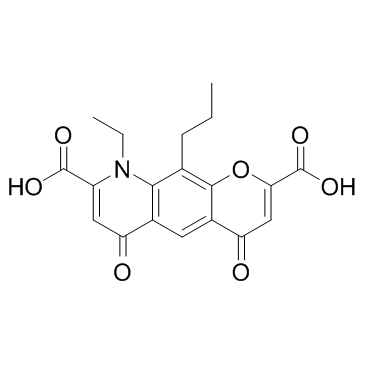69049-73-6
| Name | nedocromil |
|---|---|
| Synonyms |
Nedocromil
Nedocromilum 9-Ethyl-4,6-dioxo-10-propyl-6,9-dihydro-4H-pyrano[3,2-g]quinoline-2,8-dicarboxylic acid FPL 59002KP 4H-Pyrano[3,2-g]quinoline-2,8-dicarboxylic acid, 9-ethyl-6,9-dihydro-4,6-dioxo-10-propyl- 9-ethyl-6,9-dihydro-4,6-dioxo-10-propyl-4H-pyrano(3,2-g)quinoline-2,8-dicarboxylic acid Nedocromilo [Spanish] Nedocromilum [Latin] Tilade Nedocromilo 9-ethyl-4,6-dioxo-10-propylpyrano[3,2-g]quinoline-2,8-dicarboxylic acid 4,6-Dioxo-1-ethyl-10-propyl-4H,6H-pyrano[3,2-g]quinoline-2,8-dicarboxylic acid Nedocromil [USAN:BAN:INN] Alocril |
| Description | Nedocromil suppresses the action or formation of multiple mediators, including histamine, leukotriene C4 (LTC4), and prostaglandin D2 (PGD2). |
|---|---|
| Related Catalog | |
| Target |
Histamine LTC4 PGD2 |
| In Vitro | Nedocromil inhibits the release of histamine, LTC4, and PGD2 from mast cells challenged with antigen (with IC30 values of 2.1 μM, 2.3 μM, and 1.9 μM, respectively) and with anti-human IgE (IC30 values of 4.7 μM, 1.3 μM, and 1.3 μM, respectively)[1]. |
| In Vivo | Nedocromil-treated diabetic mice show significantly improved heart function compared with controls. The contractility and relaxation forces show similar improvements. However, the cardiac function of Nedocromil-treated diabetic mice remains significantly impaired when compared with normal mice. Nedocromil can significantly improve cardiac function in mice with diabetic cardiomyopathy, but the treatment cannot restore normal function[2]. |
| Animal Admin | Mice[2] 8-12 weeks old C57/BL6 male mice between 23-25 g receive intraperitoneal (i.p.) injections of 50 mg/kg Streptozotocin (STZ), dissolved in 100 mM citrate buffer pH 4.5, for five consecutive days. Diabetic mice (13-week-old) are randomly divided into three groups: 1) untreated group; 2) Nedocromil group, with Nedocromil released at the rate of 30 mg/kg per day from a subcutaneous (s.c.) pellet implantation; and vehicle group, with an inactive pellet implanted. Normal mice (non-diabetic) and normal mice that receive Nedocromil (30 mg/kg per day) are also included in this study for comparison. All sample groups included 15 mice (n=15)[2]. |
| References |
| Density | 1.5±0.1 g/cm3 |
|---|---|
| Boiling Point | 645.5±55.0 °C at 760 mmHg |
| Melting Point | 299ºC |
| Molecular Formula | C19H17NO7 |
| Molecular Weight | 371.341 |
| Flash Point | 344.2±31.5 °C |
| Exact Mass | 371.100494 |
| PSA | 126.81000 |
| LogP | 2.52 |
| Appearance | white to beige |
| Vapour Pressure | 0.0±2.0 mmHg at 25°C |
| Index of Refraction | 1.641 |
| Storage condition | 2-8°C |
| Water Solubility | DMSO: soluble2mg/mL, clear (warmed) |
| Symbol |

GHS07 |
|---|---|
| Signal Word | Warning |
| Hazard Statements | H319 |
| Precautionary Statements | P305 + P351 + P338 |
| Hazard Codes | Xi |
| Risk Phrases | 36 |
| Safety Phrases | 26 |
| RIDADR | NONH for all modes of transport |
